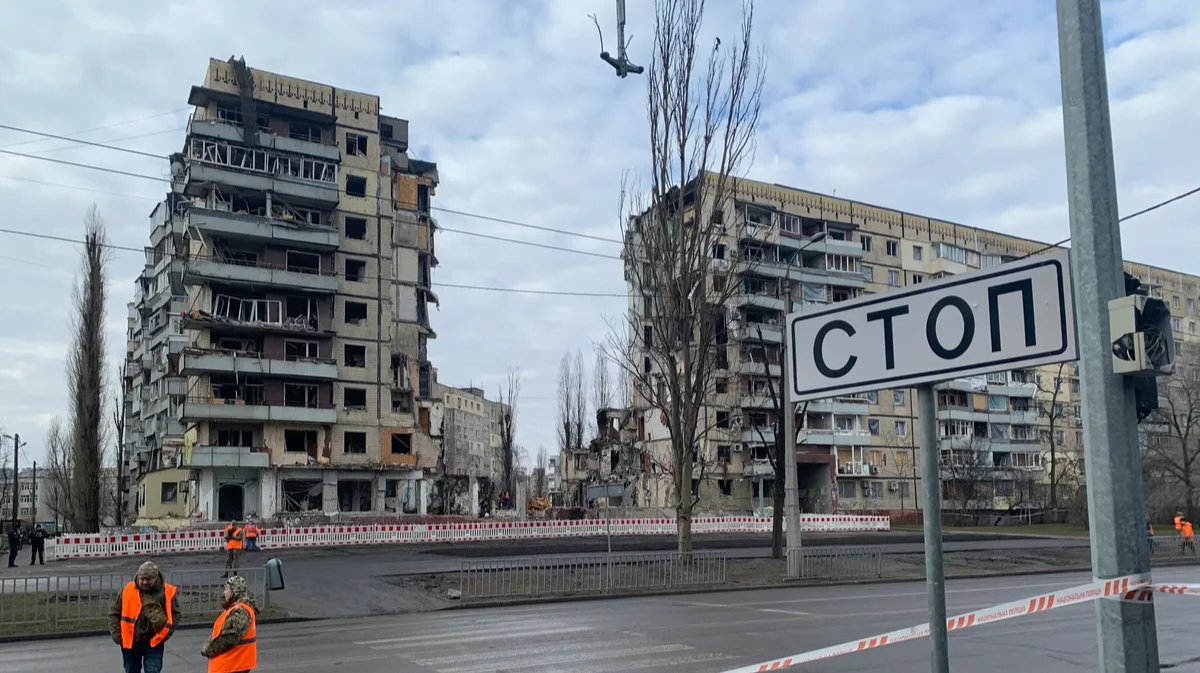Katia was the last survivor to be retrieved from the rubble. She was the thirty-ninth. Either a moan or a groan of hers was eventually heard in one out of many “minutes of silence” — a well-known method emergency workers use on rescue missions when machinery stops working in the middle of ruins and people literally stop breathing for a while. There’s a short video on the Internet — a rescue worker, standing amid clouds of smoke and dust, says in a loud, decisive manner: “Madam, yell one more time for me!” And then another rescuer joins him, begging her with pain and anguish in his voice: “Give me a sign! Once again, please!”
Katia, 27, used to be a happy wife and a young mother even despite the ongoing war, up until 15:43 on 14 January 2023. It was a miracle she was eventually found because Katia could not hear since she was born, and used a hearing aid, just like Oleksiy, her husband of the same age. They have loved each other since they were children; Mykyta, their son, was born just a week before the Russian invasion had started. It is impossible to imagine how Katia, awoken in absolute silence (the hearing aid was of no help in this cavern of stone under dozens of tonnes of smashed concrete), could see the flashing display of her cell phone, receiving a call from mother. No son or husband nearby.
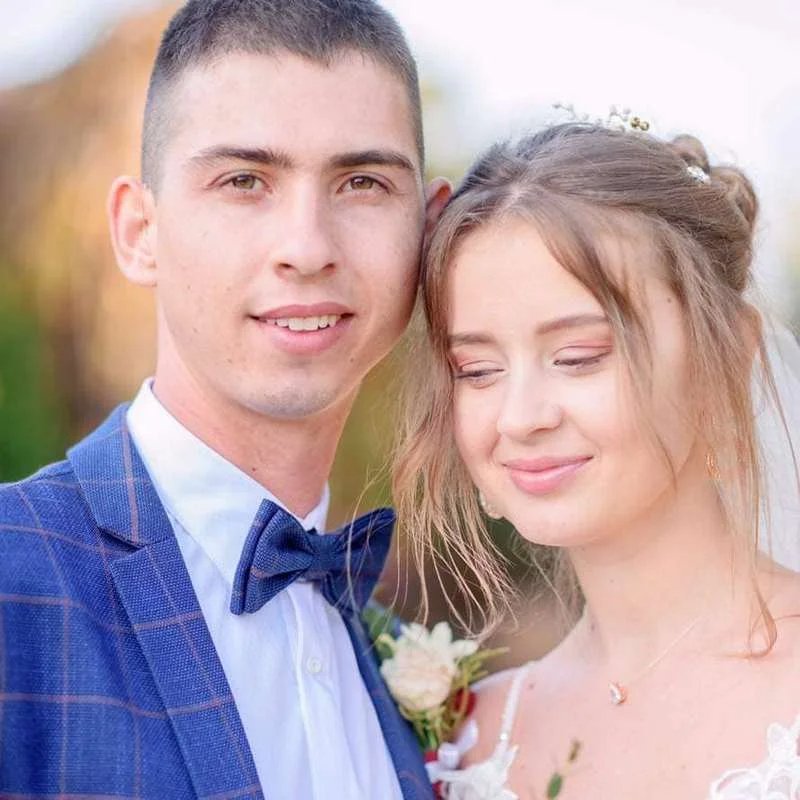
Katia and Oleksiy. Photo: social media
Katia was delivered to the ICU almost 24 hours after the strike, semiconscious, with a body temperature of 31°C. She spent a January night, although an unusually warm one for this area, wearing a sleeveless T-shirt and a pair of leggings. Her entire body was covered with bleeding abrasions. Serhiy Ryzhenko, the chief of the Dnipro regional hospital, posted a photo on his Facebook page three days later, showing words written on a piece of paper. Psychologists asked Katia to write down what she remembered: “While we’re in kitchen husband sits drink tea and son on stool I’m with him I feed him and then blast”…

Katia with her son. Photo: social media
This is what Doctor Ryzhenko and his co-workers recall from 14 January: “Everyone brought over here after the Dnipro explosion had their faces caked in blood and their bodies covered with construction dust. It was nearly impossible to determine their age. There were pieces of metal, concrete and stone in their chests, heads, and limbs. There also was a horrendous crying sound coming from people who managed to identify their relatives.”
Here is what Ryzhenko wrote about Katia: “She received a lot of medication in the ICU, and her face colour eventually turned from sallow grey to pink. She’s even trying to smile. All her thoughts are about her relatives. She still doesn’t know the truth.” The truth is that Oleksiy and little Mykyta were killed.
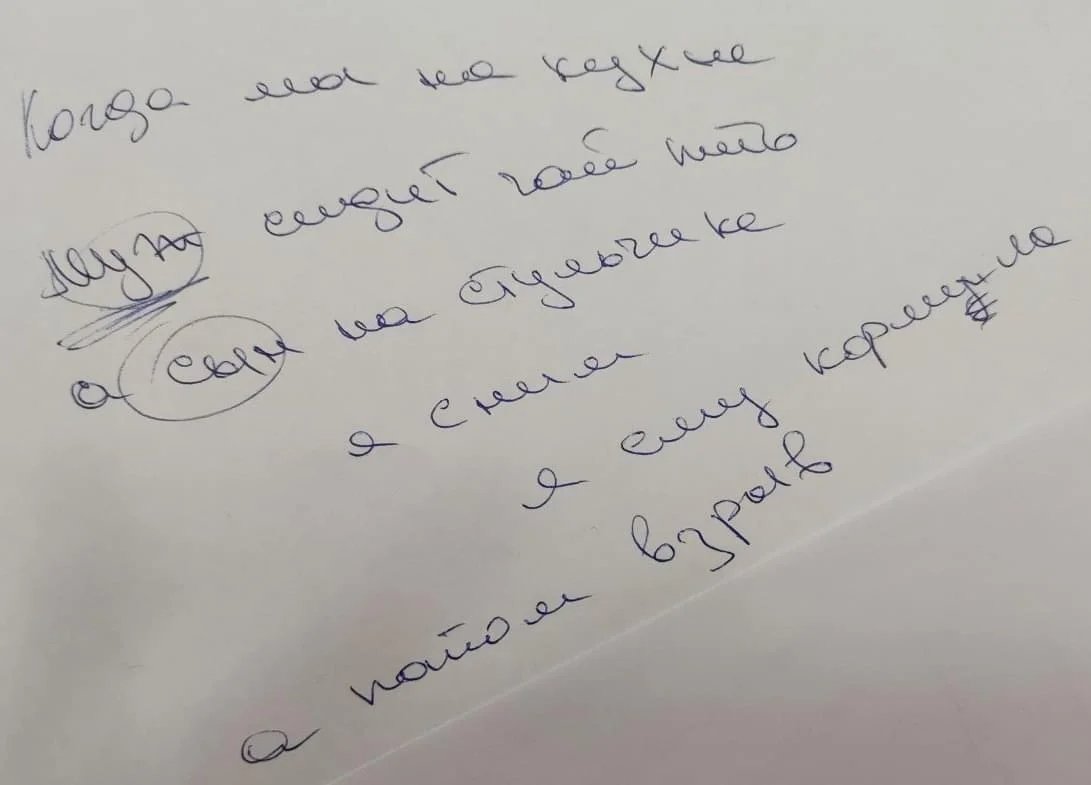
The note published online by Professor Serhiy Ryzhenko, head doctor of the Mechnikov Dnipro regional hospital. Photo: Facebook
Perhaps some of you may want to learn the statistics.
As of late 24 January, it is as follows: a total of 39 people, including six children, have been rescued following the missile strike upon the nine-storey apartment block. A total of 80 people were injured, including 16 children. The Russian army killed 46 civilians, including six kids. A total of 23 bodies were retrieved from the rubble, the rest were found near the epicentre of the missile strike, meaning those were passers-by outside the building. Four more died in hospital. Fifteen of the killed remain unidentified, their remains were handed over to forensic experts for identification. A total of 11 people are considered missing.
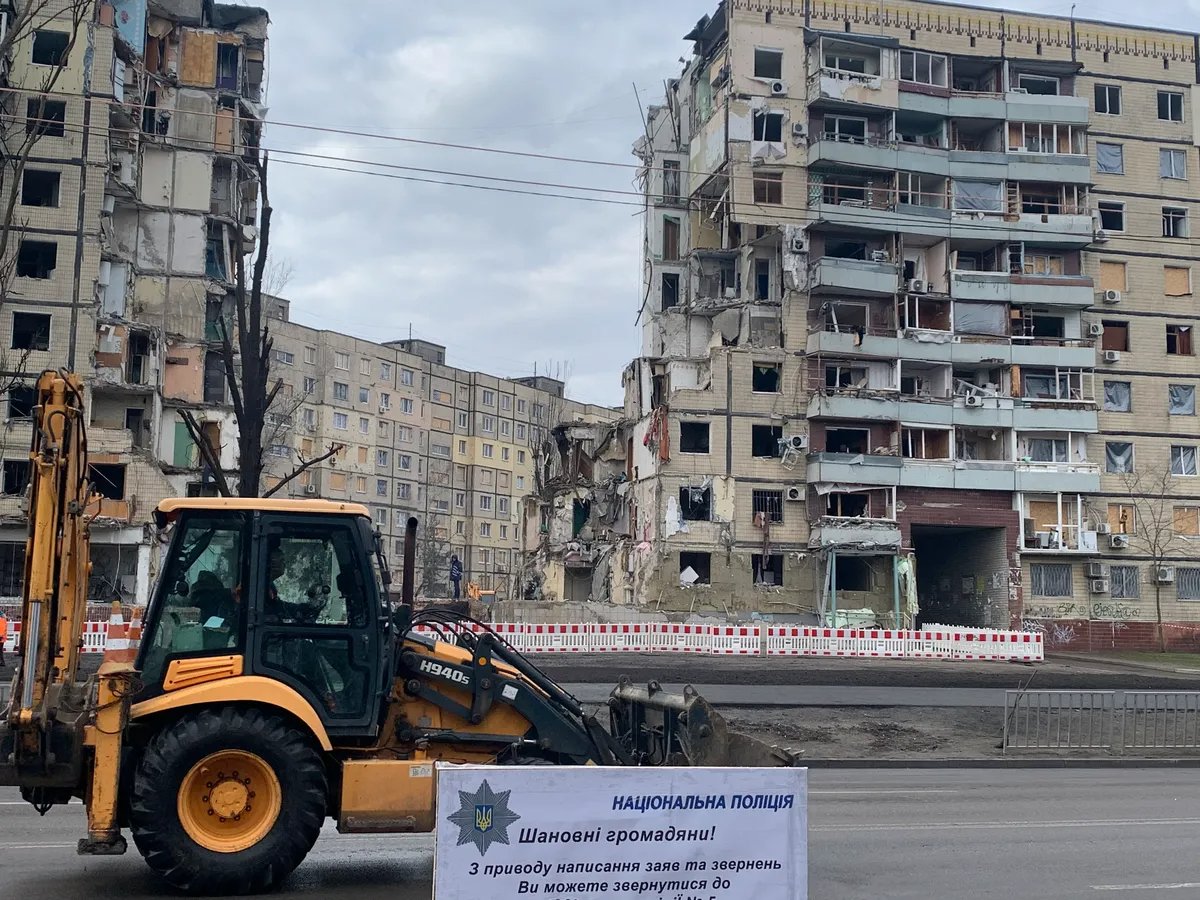
118 Victory Embankment apartment block. Photo: Olga Musafirova, exclusively for Novaya Gazeta Europe
The 118 Victory Embankment apartment block had two of its sections destroyed, 72 apartments total, and 230 more apartments were damaged. There are 16 sections in the block overall, home to about 1,700 people. The burning that followed the explosion was contained at 20:13 on 14 January (the remaining missile fuel caused a heavy fire). The fire was completely extinguished at 15:32 on 15 January. Personnel of the State Emergency Service, the National Police, the National Guard, emergency medical services, the Red Cross, as well as utility workers, 579 people in total, including 130 volunteers, and 91 equipment units worked on the site. A total of 7,920 tonnes of destroyed building fragments were carted away from the area. About 500 people are in need of housing.
It was decided to halt the rescue operation on the afternoon of 17 January. Emergency workers, firefighters, medics, the police, the National Guard, local officials, and the city folk formed up endless lines. From one side they had a collapsed building nine storeys tall, from the other there was a huge pile of flowers and toys by a bus stop with its roof twisted… Ambulances and fire trucks switched on their sirens. The sound went up into the sky, and rain started falling.
This farewell ceremony did not mean the search was over. Indeed, its most traumatising part was still ahead. Borys Filatov, the mayor of Dnipro, told Ukrainian TV: an inspection of roofs of neighbouring buildings which had their windows smashed and balconies damaged by the explosion wave lies ahead. Body parts of victims may have ended up there. He added one more thing: “There is a chance that some people simply vanished.” I will soon explain what this means.
A lamppost near the makeshift memorial has an announcement glued to it, sharing a phone number of a mental help hotline for the rescuers. The fighters of the National Guard who retrieved flattened body remains from the rubble are not made of steel.
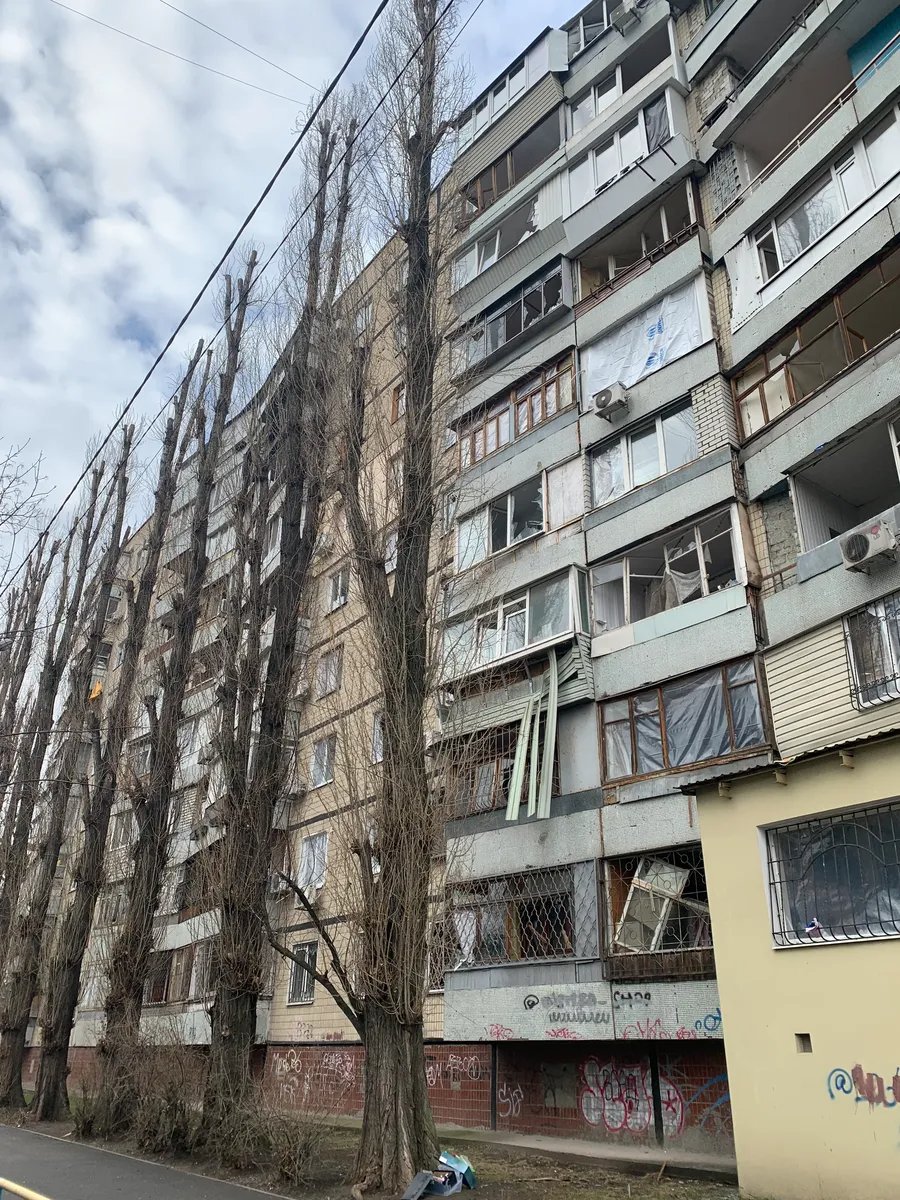
118 Victory Embankment apartment block. Photo: Olga Musafirova, exclusively for Novaya Gazeta Europe
The inner grief
The 118 Victory Embankment apartment block has the shape of a horseshoe with a yard inside of it.
The outer side of its lateral sections are almost intact. Closer to the explosion site, signs of the tragedy are becoming more obvious. As I reach the epicentre, I see the same images brought upon by this war that we had seen in Kharkiv, Mykolaiv, Kherson. A Nike jacket remains hanging on someone’s balcony, the wreckage of the apartment beyond it. There’s a red carnation lying on a hedge that goes around the front garden just under the building’s windows. It looks like there used to be a well-groomed yard out here: groups of trees, flowerbeds, and swings for kids.

Memorial near the building. Photo: Olga Musafirova, exclusively for Novaya Gazeta Europe
Now there is only a strong burnt odour here and a teddy bear on a bench, soaked in raindrops. There’s a woman sitting next to it, wearing bright coloured overalls that seem a bit large to fit her, and a hoodless jacket. She sees me, a stranger, and waves me away, as if to say: “No! Do not come closer!” Those who lost their closest ones are now going through the stage when the grief is already inside them. They don’t need to cry or retell others how it was for a hundredth time.
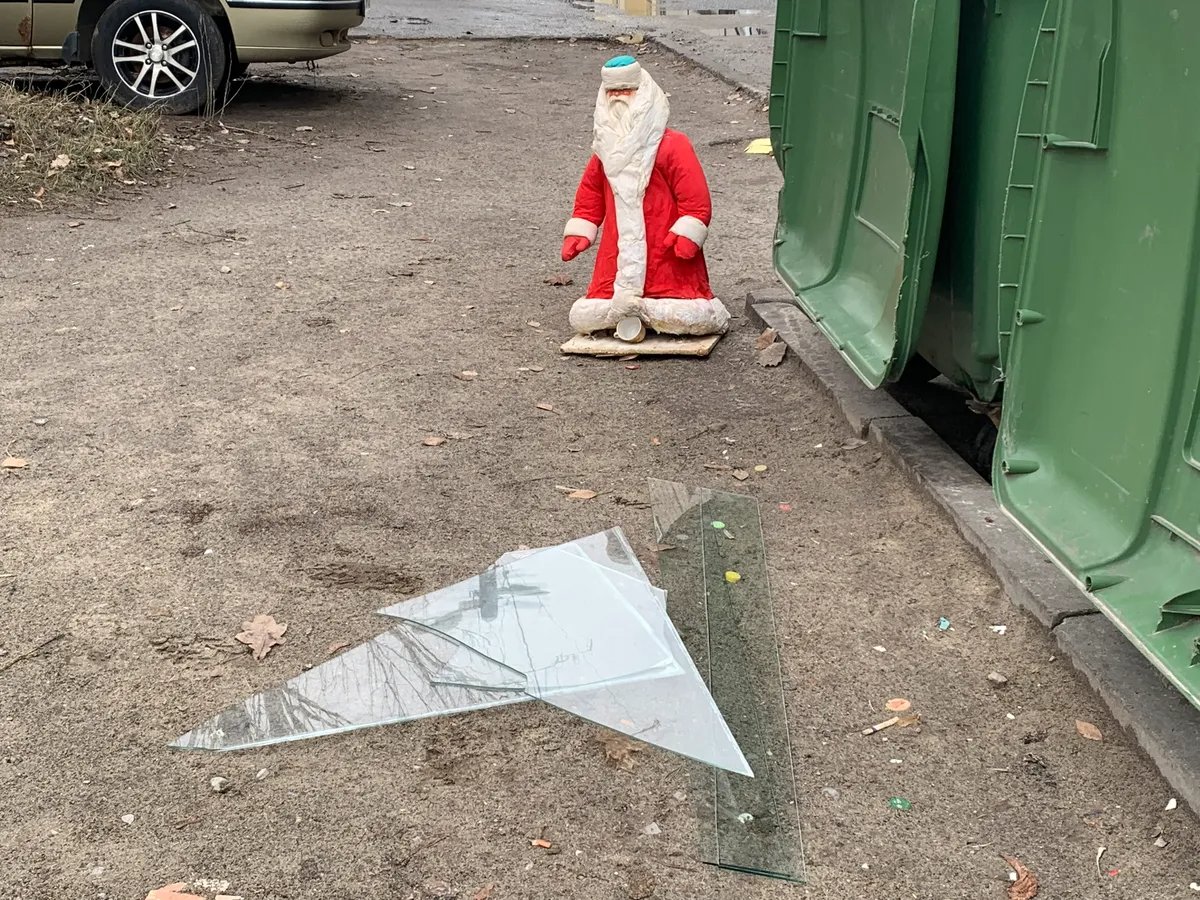
A Father Christmas figurine near a trashcan. Photo: Olga Musafirova, exclusively for Novaya Gazeta Europe
School#66 is located close to the apartment block, especially the pre-school and the primary school wing. The interiors look like an artefact from the Soviet era: lino flooring, curtains with embroidered flowers, and mazes of narrow corridors. The only new things here are signs reading “Shelter” and “Humanitarian aid HQ”.
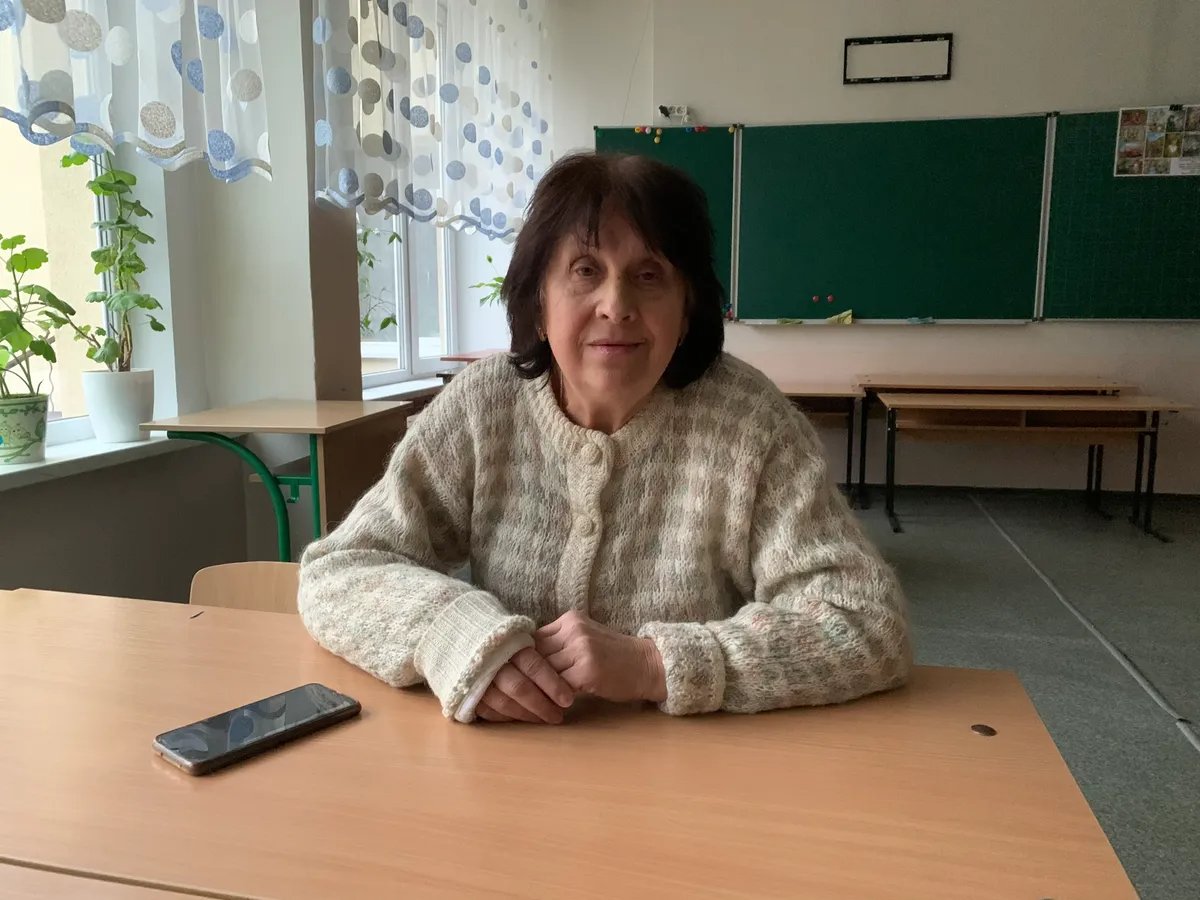
School principal Lyudmyla Korobka: “Alumni are calling me from all over the world. It’s like this missile killed them.” Photo: Olga Musafirova, exclusively for Novaya Gazeta Europe
Ksenia Sushko, the chairwoman of the Dnipro humanitarian department, brought me here when the twilight started to kick in, and the principal’s assistant met me carrying an LED torch. The school building has been in blackout since the missile strike. Lyudmyla Korobka, the principal, broke her arm when she was trying to evaluate the damage to school property, like smashed windows, for example, and tripped in the dark on 14 January. Fortunately, all Dnipro schools have been teaching online since September.
Teachers bring humanitarian supplies and bags with warm clothes to one of the classrooms, anxiously asking each other: “Should we move the desks and the chairs now or in the morning?” Various services will soon start collecting aid here. Workers outside the building are already setting up a huge power generator.
“We’ll bring you a Starlink, too!” Sushko promises. “You will be having good connection and won’t need to run around the place looking for signal anymore!”
Lyudmyla Korobka is smiling humbly. The online teachers couldn’t even dream of a Starlink before…
The town hall has prepared a special questionnaire: the people are so stressed out that they do not consciously realise what they need most, apart from recovered documents and monetary aid. The questionnaire allows them to tick off what is needed: “Power banks, laptops for children to study, underwear, winter clothes, first aid kits, hygiene items, baby boxes with diapers, baby food, food and medicines for pets, and pet carriers,” Ksenia reads out the positions from a chart on her smartphone.
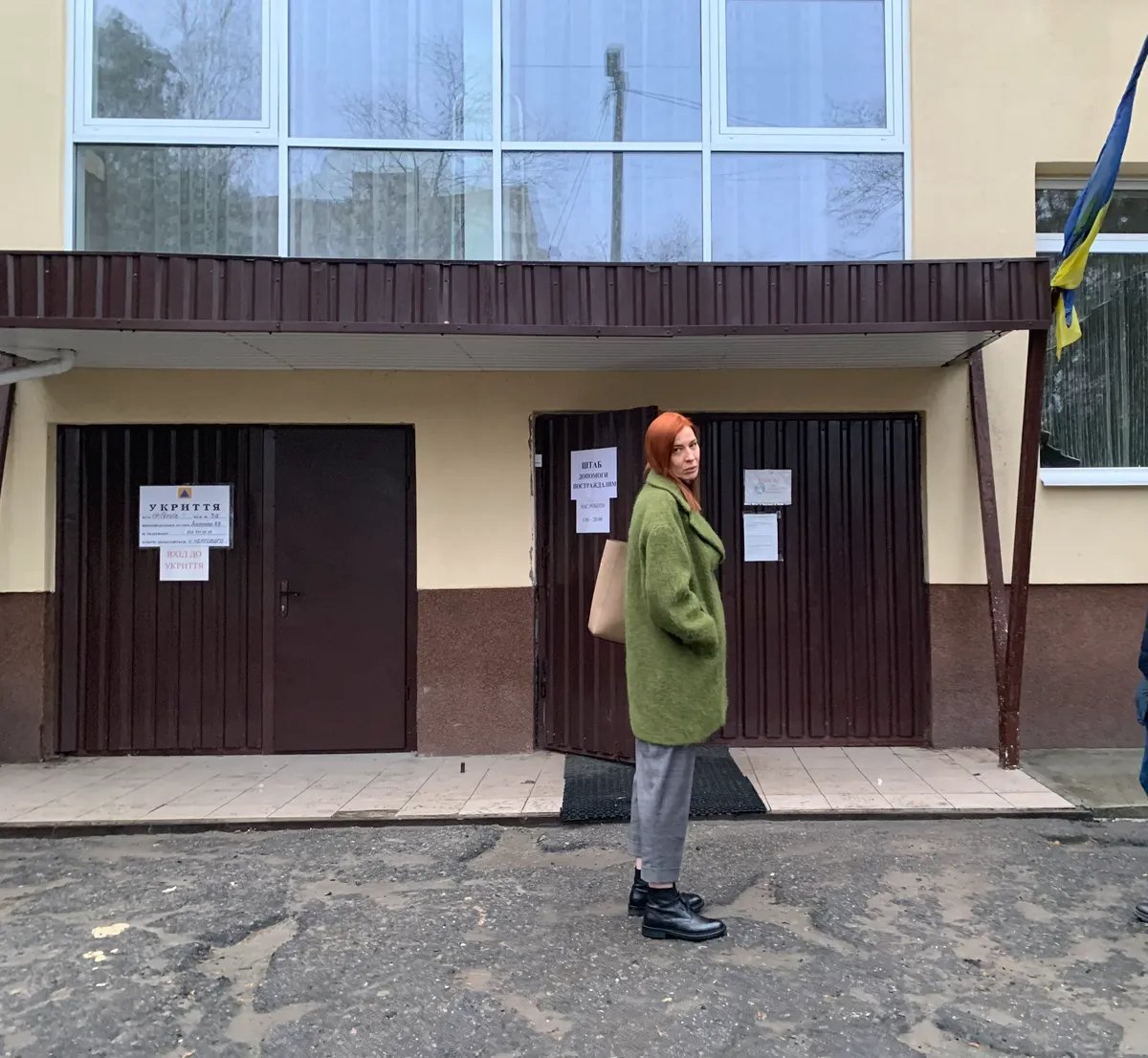
“Shelters were not needed. Citizens were just taking those affected by the hand and bringing them to their homes,” says Ksenia Sushko, chairwoman of the Dnipro humanitarian department. Photo: Olga Musafirova, exclusively for Novaya Gazeta Europe
In the middle of the residential quarter, there are two more schools and an out-of-school education centre. It was initially planned to set up residential shelters for those who suffered from the attack. The entire neighbourhood started bringing all sorts of items here: blankets, pillows, bed sheets, towels, groceries — from canned food to meatloaves, boiled eggs and flasks with tea.
“The shelters remained empty, though. Nobody stayed for the night.”
“Why?” I ask.
“Look, there at the roundabout where the police set up a roadblock, huge lines of vehicles gathered. The locals would just take people by their hands and take them away — not only their relatives, friends, or co-workers, but genuinely random people. They’d say: ‘Our apartment is big enough to fit a family with children! We can do it, too! The conditions that we have to offer aren’t much, but we can fit everyone in.’”
Then we sat in a classroom with Lyudmyla Korobka for a long time. She spoke of a list she compiled with her co-workers.
“Masha Lebed, Class 9A. Killed. She was an A-student, a ballet dancer, a smart and pretty girl, and a leader… Her mother is a teacher, works in an English-language school. The father died four years ago.
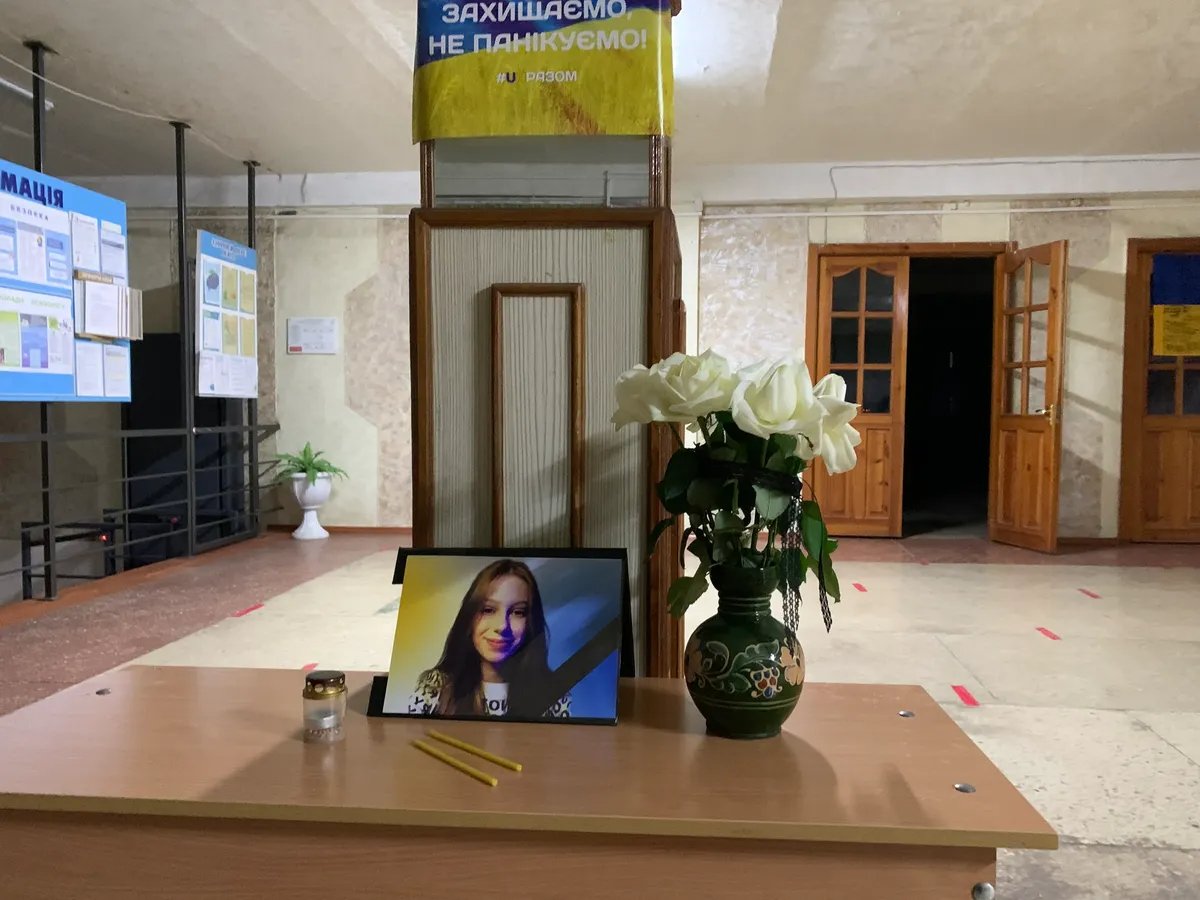
Masha Lebed, a ninth-grader killed in the attack. Photo: Olga Musafirova, exclusively for Novaya Gazeta Europe
Myroslava Movchan, Class 4A. She’s alive! Has polytrauma, though, legs broken, head wounded. Our teacher Olena Shakhova, she graduated from our school back in the day, was standing downstairs out there and prayed to God to let the girl’s parents live. They gave her a call and said: we’re in the kitchen, that’s all that’s left of our apartment! And then the rescue squad took Myroslava out, so Olena travelled to the ICU with her. She is slowly getting better now.”
Lyudmyla continues, voice down to a whisper:
“I tell you what, we posted on Facebook right away and shared credit card information of those parents who were in the toughest situation. I’m not even going to tell you how much money people have donated so far! A-huge-lot! My phone is red because of how many calls I keep receiving. I have worked as the headmistress since ‘85. Two or three generations of our graduates keep calling me from all over the globe. This place is where they grew up, lived, walked the streets, and fell in love. It’s like the missile killed them, too…”
Lyudmyla goes on with the list:
“The family of Tymur Shevchuk, Class 3D, refugees. Tyma was returning home from training with his sister, and they entered the building. The boy then told his teacher when he was in hospital: ‘Something fell on my leg.’ That was a hot water radiator… The girl was injured, too. Their parents were found dead eventually, so their grandparents are taking custody of them now, it’s a good thing they’re still young enough to do so. The Fihurniys family. Maryna is our graduate, too. She came over to her parents with her husband for the Orthodox New Year. The whole family gathered in the apartment, seven people in total. A feast! Only Maryna’s mother survived… The Shvets family. Nastia used to go to our school, and her mother helped us a lot, she was the permanent chair of the parents’ council. Her father was a great man, too, he used to help us renovate the building. Both of them were killed…”
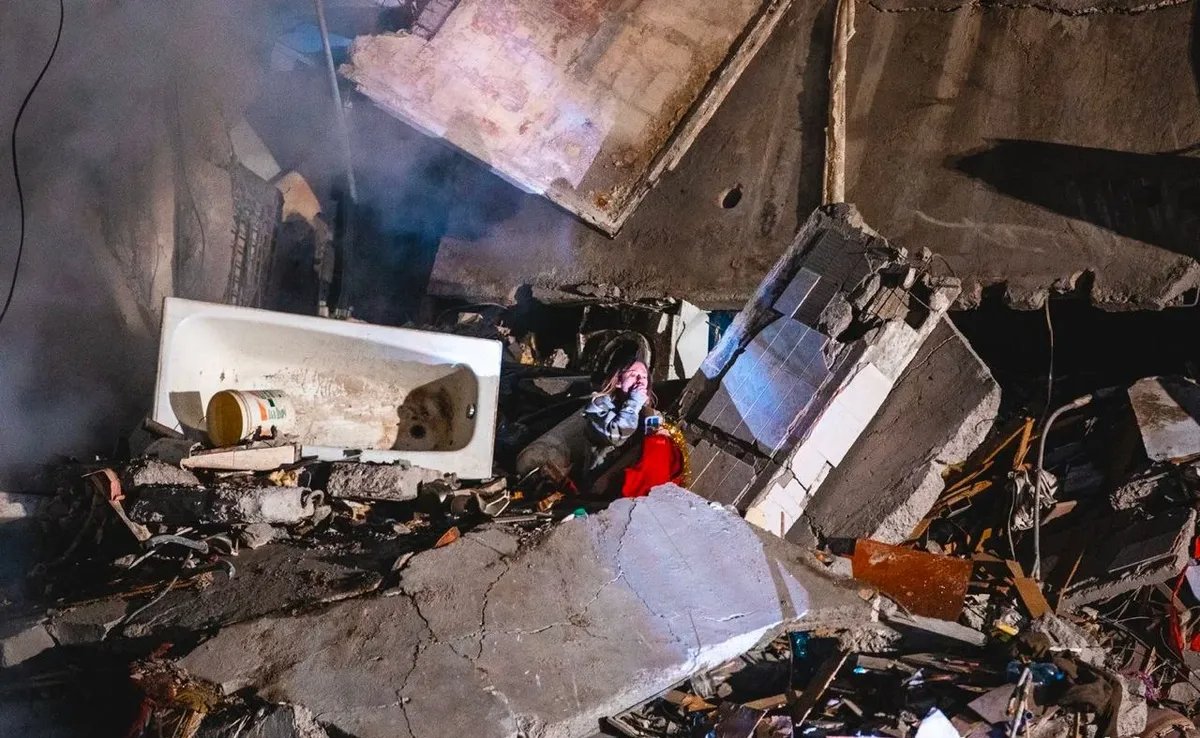
Anastasia Shvets. Photo: Telegram
It seems like the entire world has seen the photo of Anastasia Shvets, a young woman, sitting near a bathtub atop the collapsed building, holding a fluffy toy (this is what reporters thought) and a tinsel garland. She was left completely orphaned. Nastia lost her boyfriend in September — he was killed on the front line. In that picture she was actually holding her dead cat rather than a stuffed animal. A Dnipro Facebook group on homeless cats wrote: “Nastia’s mother was an animal volunteer, she helped us nurse animals in the shelter, and took some home”…
Lighting our path with torches, I, Lyudmyla Korobka, and Viktoria Kurylo, the Director of Studies at the primary school, go to see the neighbouring wing of the building. There’s a photo of Masha Lebed smiling in the hall, a black band going over the corner of the picture. It was taken from a wall mount on the first floor. Viktoria tells a story that happened yesterday: a local official gathered people in the shelter (this is what the school’s boxroom in the cellar of the building is called these days). The people who came there were those who suffered from the strike but were not admitted to hospital. The official would tell them how monetary aid would be paid and how the paperwork would go.
“Many came with their children, scared of leaving them alone in apartments. They all had black eyes and abrasions from the explosion wave. One father was holding his six-year-old son by the hand, and his younger son, with bruises, too, on his hands. Someone came in, and the door banged. The kid started crying: ‘Dad, missiles, missiles! I’m scared!’” Viktoria says.
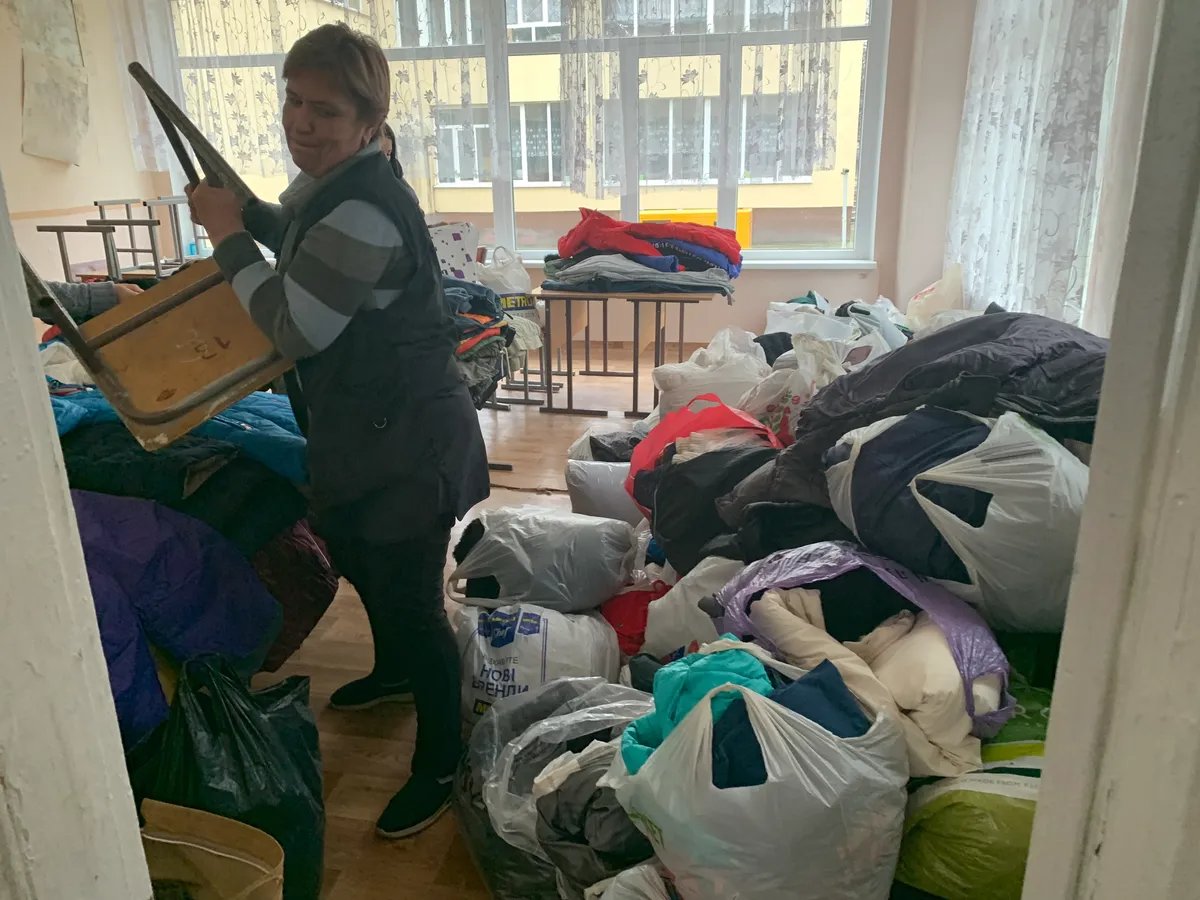
A crisis centre to help out those affected was set up at the school, teachers are carrying bags with warm clothes. Photo: Olga Musafirova, exclusively for Novaya Gazeta Europe
There is one more thing.
Yes, the local council provides money to bury the victims, and the injured receive considerable pay-outs for medical treatment. Yes, all utility bills for residents of the building were made null and void, and they will receive any help in case their apartments are not beyond repair. Yes, each family affected by the disaster will receive up to 1 million UAH (around €25,000) in cash from the city budget. The regional administration promises to provide the same amount, plus additional money from donors and charity foundations. People may use these funds to purchase any housing they like, even abroad. This will not return the dead, of course, although the living will try to live on.
But here’s a pinch of common sense: this was neither a tragic accident nor a natural or industrial disaster! And yet another Russian Kh-22 missile which Ukraine’s air defence cannot cope with so far may hit another building, not just in this neighbourhood.
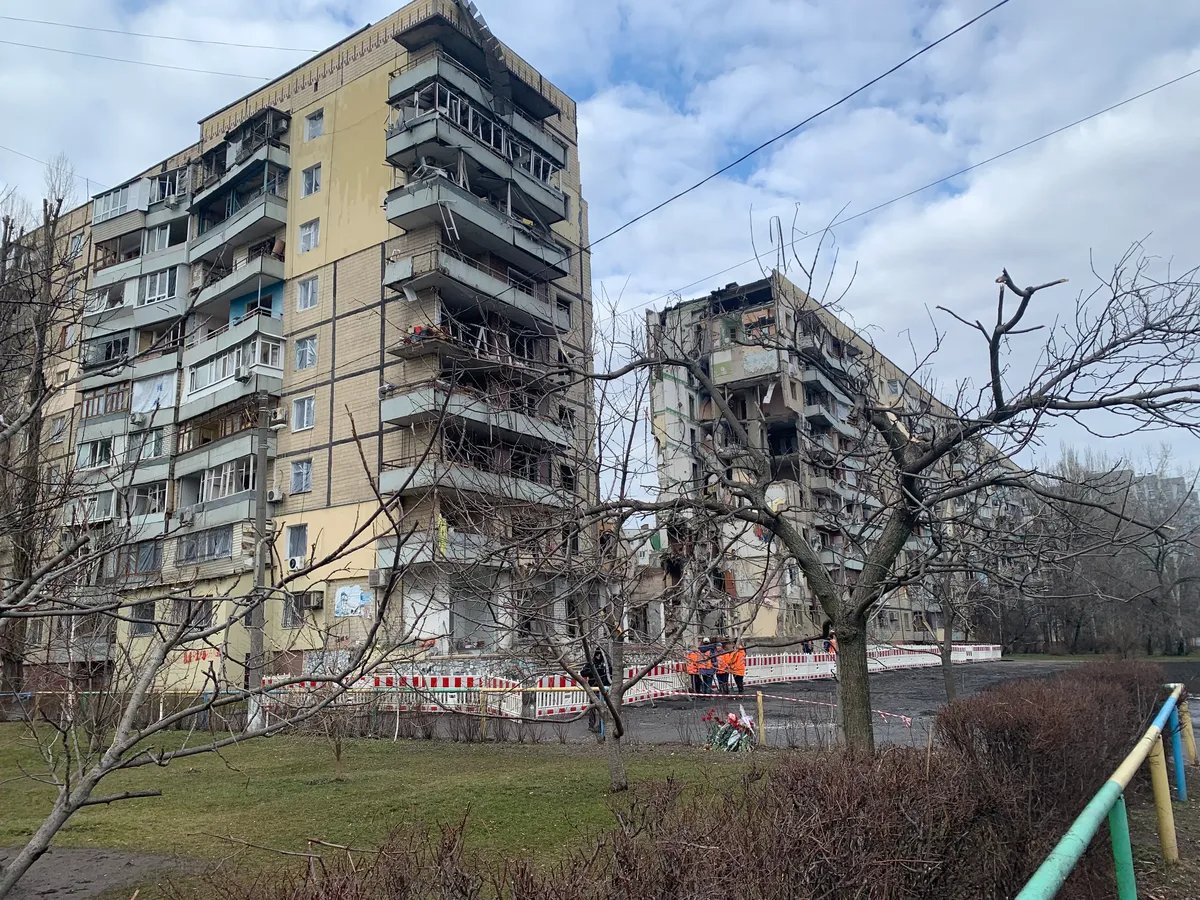
118 Victory Embankment apartment block. Photo: Olga Musafirova, exclusively for Novaya Gazeta Europe
Shelter-less
The word neighbourhood sounds like a euphemism in this case: 100,000 people. A city within a city. The best residential district in the country, even though it is filled with prefab panel blocks made from inexpensive materials.
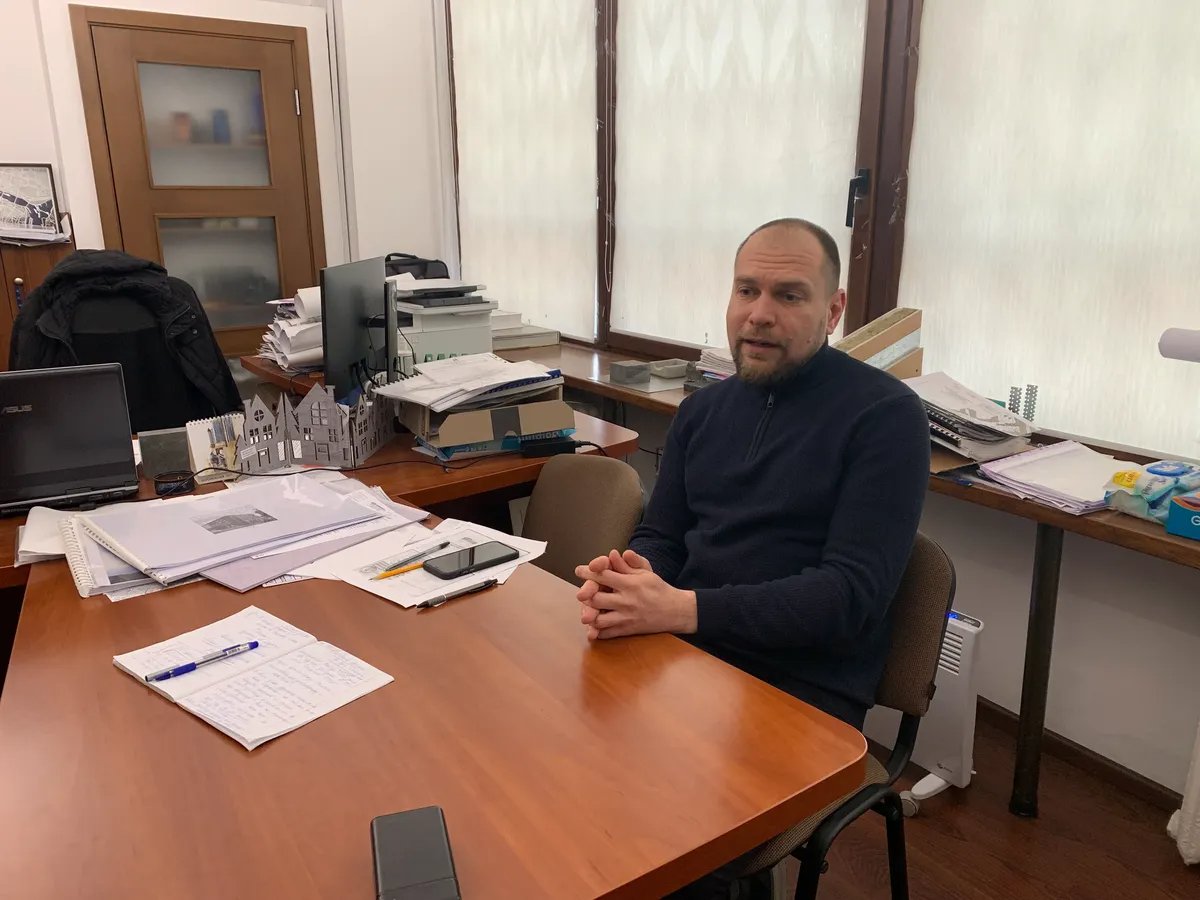
Dnipro’s chief architect Dmytro Volik: “We were constructing buildings to make them comfortable and aesthetically pleasing. And now we are basically forced to discuss cave designs.” Photo: Olga Musafirova, exclusively for Novaya Gazeta Europe
“The Victory neighbourhood is still very much in demand even though the buildings are not the newest. 80% of Dnipro’s residential buildings are inherited from the Soviet Union, it is what it is,” says Dmytro Volik, Dnipro’s chief architect.
I came to ask him a few questions about the future of the nine-storey building on the Victory Embankment in particular and housing in Dnipro in general. My logical thinking was telling me that comfort and aesthetics will now be shoved to the background to give way to security.
“Do these houses have bomb shelters?”
Dmytro looks at me with compassion, like at a person who treats the “Immediately proceed to bomb shelters when air sirens sound off and do not leave them until they turn off!” warning literally:
“Shelters were last built in Dnipro in the 1950s, during the Cold War. At strategically important industries like Yuzhmash, [they were built] strictly to cater for employees.”
Our conversation in his office was taking place right in the middle of air-raid sirens which both of us ignored. Because what is the point? Only the blinds were down to cover massive window walls in the chief architect’s office.
I already knew that the Dnipro metro is one of the shortest in Europe: only one line and six stations. The metro just could not shelter any significant number of people like in Kyiv. I also did not really see any underground passages or parking lots here.
“Let’s be frank, our modern residential buildings, which are very much sought after because of their proximity to water, are built on alluvial territories with a relatively high level of groundwaters,” Volik notes. “It’s impossible to build normal shelters that go deep into the soil there because we’ll just submerge in water.”
“But the reality is such that the war with Russia will continue for a while still. How can Dnipro, for example, preserve itself?”
“Use Israel’s experience, how else? Building not just separate shelters but houses with dual-purpose spaces. Weapon hits similar to the one on the Victory [Embankment] can destroy buildings. However, we can minimise the level of destruction by employing construction solutions. A thick reinforced concrete core at the centre of which there is a security room, monolithic staircases inside the building, while the outside perimeter construction assumes most energy released in an explosion… The cost of these buildings is astronomical.”
Dmitry pauses: his whole life, he was doing project work but never factored in or tried to comprehend security issues like this.
“Me and my colleagues were talking about space solutions which reveal landscape focal points… And now we are practically discussing cave designs. The whole civilisational process that humanity is going through — from the standpoint of acquiring normal and correct values — has been derailed by the war unleashed by Russia. Our political neighbour is a savage that is seeking to drag the whole world into savagery.”
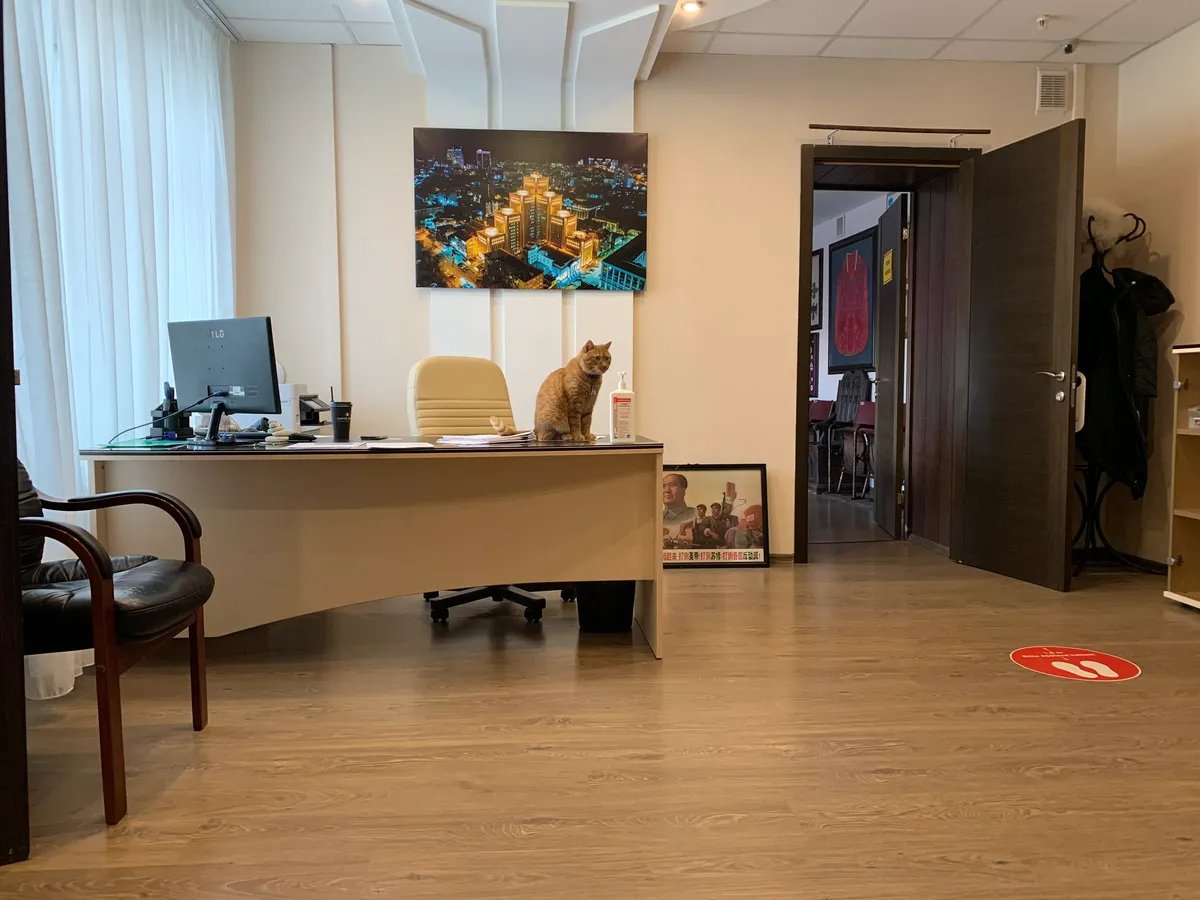
Biden the cat feels right at home in the Dnipro city council. Photo: Olga Musafirova, exclusively for Novaya Gazeta Europe
‘There was no overshoot here’
There are only two options. You either all go down to the caves or strip away the savage’s freedom to act.
While I was waiting in the reception area for Mykhailo Lysenko, Dnipro Deputy Mayor, I met a ginger cat called Biden who roams over all officials’ desks and sees all chairs as his scratching posts. Biden has an excuse: he was not named to pander to political beliefs, the name came five years ago when he was adopted from the streets. Lysenko’s office, meanwhile, has a large portrait of Reagan which has been hanging there a while. You can say that “aggressive dependence on the US” is clearly visible.
Mykhailo spent more than two days near building 118 while the rescue operation was underway. He saw everything with his very eyes. Workers at two special ranges are now sifting through the rubble brought from the tragedy site by hand.

“There was no overshoot here. It is a deliberate act of intimidation of Dnipro residents,” Mykhailo Lysenko, Dnipro Deputy Mayor, is certain. Photo: Olga Musafirova, exclusively for Novaya Gazeta Europe
“I found melted metal pieces of strange sizes and forms. Steel bars melted in the heat. You can only imagine what happened to the bodies…”
“Did the bodies evaporate?”
“Yes. The missile struck the third, fourth, and fifth floors. No one survived there. Concrete turned into sand in the heat. And another thing. Concrete slabs on lower floors folded like dominos. A slab is lifted, wind rushes in, and here we go again. Fire is then extinguished. The next slab — and the same story. We had some national emergency service staff who worked in Mykolaiv. When they reached the fourth floor, before the rubble clearance, no one even knew what missile it was, they were the first to say Kh-22. ‘Why?’, I asked them. ‘The smell! The burned fuel is unmistakable. Well, the nature of destruction as well’.”
I’ll remind our readers:
On 29 March 2022, the Russian army fired a cruise missile at an administrative building that housed the Mykolaiv regional administration. The missile struck the building right in the middle, the third and fourth floors. The building went ablaze straight after the strike, emergency services struggled to put it out. In total, 37 people were killed: administration staff, territorial defence unit members, and servicemen.
We can surmise with a high degree of probability that the missile attack was targeting a single person: Vitaliy Kim, head of the Mykolaiv region. The scathing and caustic nature of TV comments by Kim directed at Putin and the Russian army reached its height at the time. Vitaliy overslept and was late for work, which saved his life. His secretary did die, however. Air raid sirens did not sound off in Mykolaiv before the strike: a Kh-22 travels at a speed of 4,000 km/h. Missile launchers simply do not have time to detect and intercept it.
According to Mykhailo Lysenko, Russians intended to strike the targets both in Mykolaiv and Dnipro rather than hitting them by mistake:
“I believe that there was no overshoot here. Judging by the technical characteristics, Kh-22’s mishit range stands between 300-500 metres and not anywhere close to three kilometres as to our Prydniprovska thermal power plant located on the opposite bank. The thermal power plant has chimneys, it’s a huge facility which is dozens of times bigger than a residential building. You just cannot miss like that. It is a deliberate act of intimidation of Dnipro residents. And we must respond to it.”
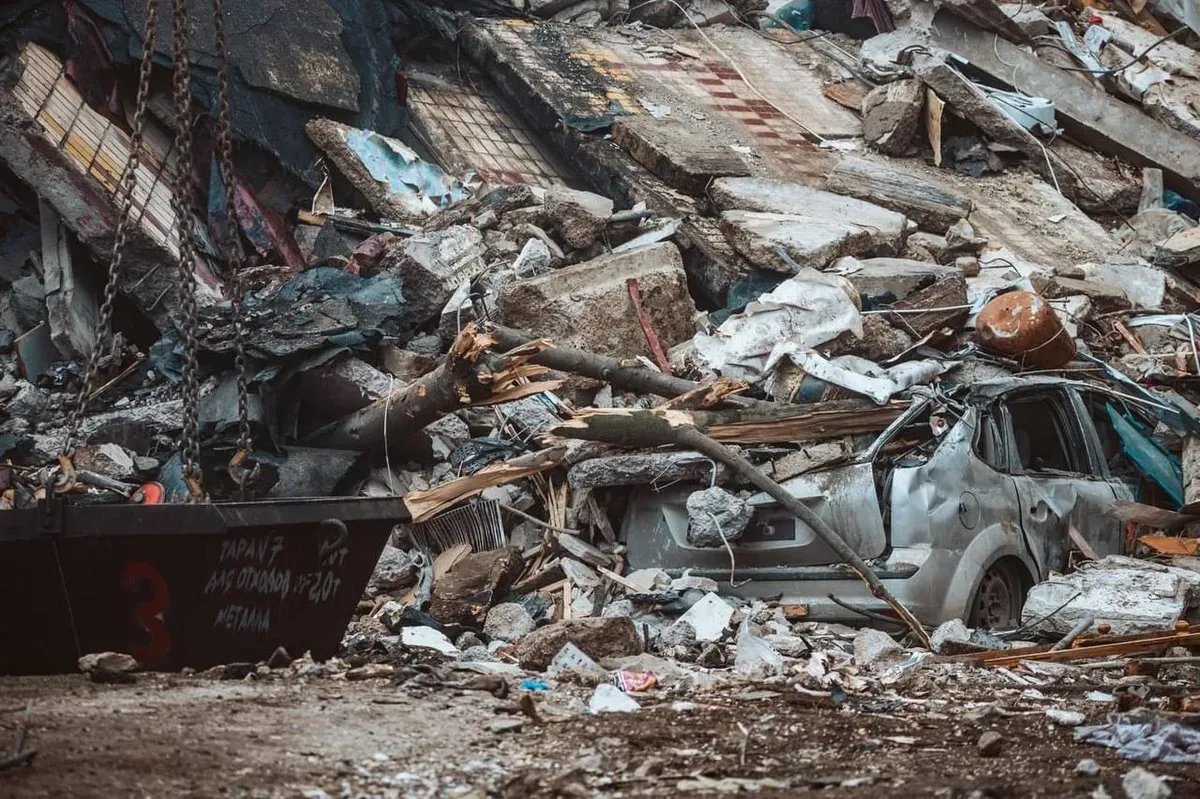
Building rubble. Photo: Telegram
Korban’s offer
The Ukrainian Wikipedia has this entry on Hennadiy Korban: “A Ukrainian statesman and politician, businessman, racketeer in the past, a political dissident in exile”. Head of the UKROP political party which has now de-facto ceased to exist. In July 2022, the news emerged that Ukrainian President Volodymyr Zelensky had signed a presidential order to strip Korban of his Ukrainian citizenship. Hennadiy himself (still quoting Wikipedia) learnt about this when he tried to return to Ukraine when his Ukrainian passport was confiscated on the border.
These facts do not, however, stop Korban from still leading Dnipro’s public council, participating in the city’s public life, speaking live to local TV channels, and so on. His name is somewhat of a password in top offices, the army of his supporters in the region is vast and active. Moscow’s terrorist attack on the Victory neighbourhood moved Korban to make an offer for anyone who finds verified information about those who fired the missile: $25,000 from him personally to the first two “detectives”.
The reward was soon transferred to non-governmental intelligence organisations: Molfar (a person of supernatural abilities and a keeper of ancient knowledge in the Hutsul culture, an ethnic group living in Western Ukraine and Romania) and InformNapalm. Surnames, ranks, home addresses, passport details, current phone numbers, photos of the pilots serving in the 52nd guard heavy bomber aviation regiment, Military Base 33310 (Shaykovka). Even details about their family members. Moreover, there’s even indirect proof that the organisations were rewarded correctly: our colleagues from IStories managed to dial the specified numbers and get through to the Russian military pilots.
Valery Rykov, lieutenant-colonel, squadron commander, and sniper pilot, is named as the person who pulled the trigger and launched the terrorist attack (“with 95% probability” as mentioned in the list). InformNapalm specifies that the missile was fired from a TU-22M3 RF-94142, aircraft number № 42 “Red”. Rykov was likely flying this plane when the missile targeting Dnipro was launched. The Ukrainian Security Service followed suit and published the information about the Russian pilots, killers of civilians.
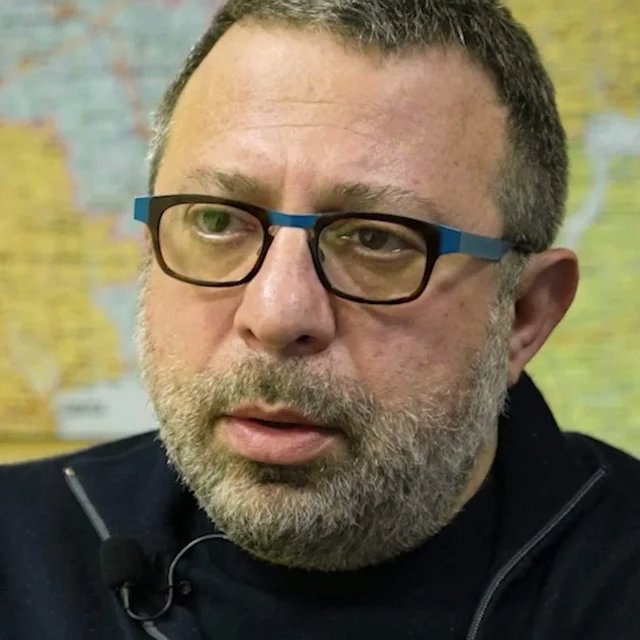
Hennadiy Korban. Photo: Telegram
I managed to get a short phone interview with Hennadiy Korban (his phone number was registered in Israel).
“You managed to identify those who attacked the Dnipro building. What else do you know? For instance, servicemen in Shaykovka already know that they are being hunted. What’s the reaction?”
“I don’t know what their reaction is. I have no contacts in Russia. However, since everything was quickly published in media outlets, Russian channels likely did it too. As far as I know, they [Dnipro building attackers] are living in some separate town, a closed town, with their families. They are isolated from the outside world.”
“You paid $25,000 as a reward for the information just to tell the world that Ukraine knows the killers by name? It is not the first time since 24 February that Ukrainian society discusses the idea that ‘We need our own Mossad’…”
“Mossad is an intelligence agency in Israel, a bit different. If you are looking for an equivalent, then there’s the Vengeance Bureau which exists in Israel even today. An NGO. Well, it is considered an NGO. It exacts retribution against those who were exterminating the Jewish people during World War II and more. There’s the 1972 Munich massacre, for example. So, there are people and they carry out [missions], but you cannot say they are in military service. Even though the military intelligence, Mossad, and the Vengeance Bureau undeniably work in close cooperation. It would be a good thing to do the same in Ukraine.”
“President Zelensky and his aides reiterate: ‘We will not forget anyone!’ Actions are needed to reaffirm the good memory. Ukraine has capabilities to act. Ukrainians fully understand the mentality of our neighbours, their strong points and weaknesses. We need to use this knowledge. We need to create structures that run parallel to the state ones which should maintain close contact with the Main Directorate of Intelligence of the Ukrainian Defence Ministry, with the intelligence community, and the foreign intelligence agency. But the people who exact retribution cannot be in state service, their names remain unknown.”
“Can this agency be viewed as a private initiative, a private company?”
“Look, I have been talking about this for a while, since 2014 when [former Ukrainian President Viktor] Yanukovych and his entourage fled the country: we have every capability to bring them back to justice. Clearly, there was no one and no time to do so then. I hope that now or after the Ukraine war there will be hotheads willing to do this job for justice to prevail.”
“So, you cannot for now specify the time? How soon can a Ukrainian version of the Vengeance Bureau be born?”
“I cannot say, yes. Because right now I am unfortunately a little removed from state politics. And I have no capabilities… But if I were invited, I think I would be able to set up this agency in Ukraine. Or people linked to the military and foreign intelligence, the army could particularly do it. Special services must be in close contact so that a parallel non-governmental organisation can be effective.”
“Do you think that this initiative — if it does emerge — will be supported by the president, government, parliament?”
“I don’t know what’s in their heads. We need to see how those in power use their capabilities and meet public demands. We are not talking about chopping heads off or gutting people. But Ukrainian society definitely wants revenge and it should be exacted. As justice or in any other form.”
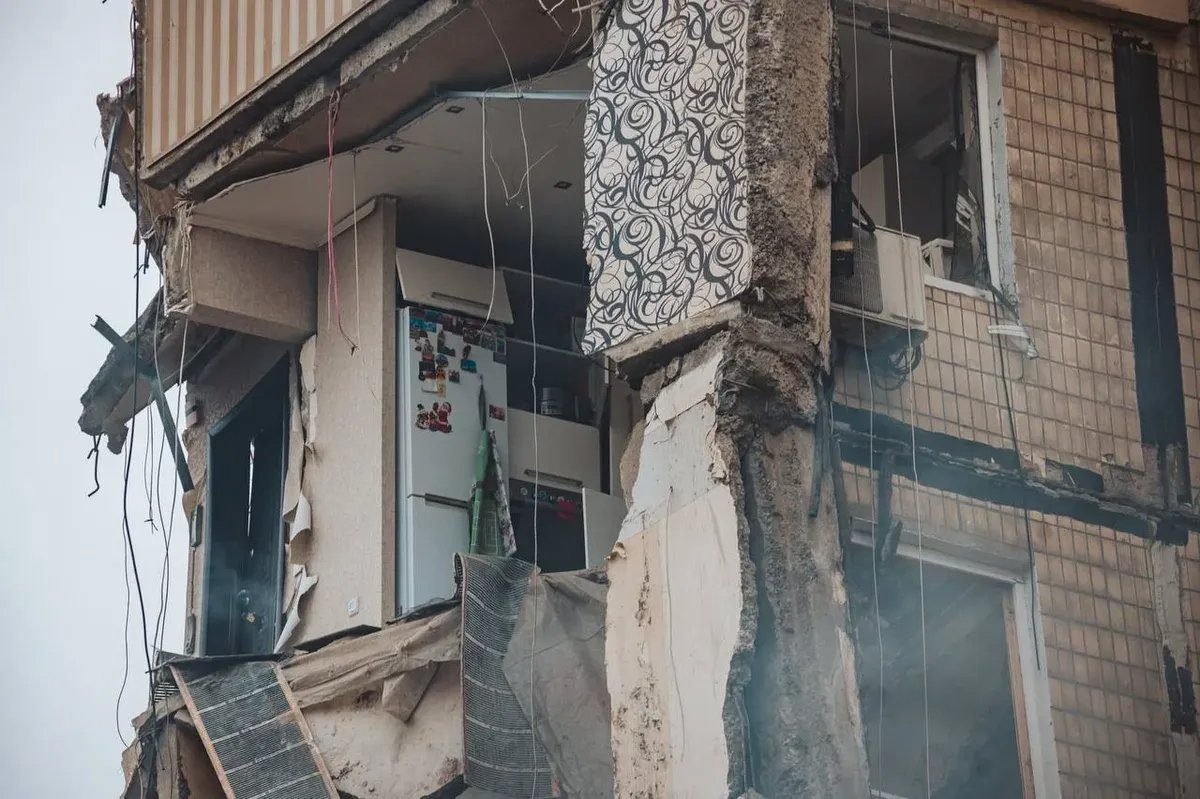
Building 118. Photo: Telegram
***
On 20 January, the Ukrainian Security Service caught red-handed a group of seven Dnipro residents who are suspected of helping Russians to launch more precise missile attacks on the city. The security service claims that they were handing information over to the enemy detailing coordinates of critical infrastructure facilities, including power plants. The detainees were travelling to the sites of missile strikes to assess their effectiveness and report back. The agency is now investigating whether the group was involved in the missile strike on the Victory Embankment apartment building.
On 16 January, the first victims were buried in Dnipro. According to medical services, 24 children were born in the city on the same day: eight girls and sixteen boys.
Dnipro — Kyiv
Join us in rebuilding Novaya Gazeta Europe
The Russian government has banned independent media. We were forced to leave our country in order to keep doing our job, telling our readers about what is going on Russia, Ukraine and Europe.
We will continue fighting against warfare and dictatorship. We believe that freedom of speech is the most efficient antidote against tyranny. Support us financially to help us fight for peace and freedom.
By clicking the Support button, you agree to the processing of your personal data.
To cancel a regular donation, please write to [email protected]
